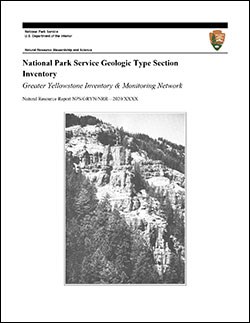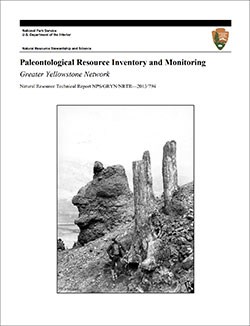
NPS photo by Jim Peaco.
Geology and Stratigraphy of the Greater Yellowstone I&M Network Parks
The Greater Yellowstone Inventory and Monitoring Network (GRYN) consists of four national park units in northwestern Wyoming, southern Montana, and eastern Idaho. Bighorn Canyon National Recreation Area, Grand Teton and Yellowstone National Parks, and the John D. Rockefeller, Jr. Memorial Parkway are the core of the 7.3-million-hectare (18-million-acre) Greater Yellowstone Ecosystem. These four units include a broad range of climatic zones, habitat types, elevation profiles, and encompass great biological and geological diversity. Geographically the network contains the headwaters of the Bighorn, Shoshone, Snake, and Yellowstone Rivers. These watersheds are characterized by landscapes influenced by a diversity of geologic processes and support distinct plant and animal communities including a diversity of large mammals. Taken together, the unique geologic, hydrologic, and biological characteristics of this region are world-renowned.

NPS image.
A Brief Geologic History
A few examples of events and Network resources in each geologic time period are highlighted below, from youngest to oldest.
Oligocene (see Paleogene) rocks are not exposed at the surface in any Greater Yellowstone Network unit, but the Miocene is well-represented at Grand Teton, primarily by the Colter and Teewinot formations. The Colter Formation is composed of volcanic debris, indicating the presence of a volcanic source near the north end of Jackson Lake between about 20 and 13 Ma. The succeeding Teewinot Formation was deposited in a large lake. A local volcanic center, the Jackson Hole volcanic field, was active around 8 Ma, but much more extensive volcanism arrived near the end of the Miocene in the form of the Yellowstone hotspot.
The first evidence of the Yellowstone hotspot in the immediate vicinity of the Greater Yellowstone Network begins near the end of the Miocene (see Neogene), with the development of the Heise volcanic field in eastern Idaho between 7 and 4 Ma. Evidence of these eruptions is either absent or buried at Yellowstone NP, but small remnants of the 5.51 Ma Conant Creek Tuff can be found in Grand Teton and John D. Rockefeller, Jr. Memorial Parkway. By about 2 Ma, the hotspot emerged beneath the Yellowstone Plateau. Three major eruptions resulted in the creation of three distinct calderas: the Huckleberry Ridge Caldera (Huckleberry Ridge Tuff) at about 2.05 Ma; the Henry’s Fork Caldera (Mesa Falls Tuff) at about 1.3 Ma; and the Yellowstone Caldera (Lava Creek Tuff) at about 0.64 Ma (640,000 years ago).
Quaternary glaciation, beginning approximately 2.6 Ma, has significantly shaped the landscape of the Greater Yellowstone Network parks, especially Grand Teton, John D. Rockefeller, Jr. Memorial Parkway, and Yellowstone NP. The Jackson Lake basin displays dramatic examples of glacial features including glacial outwash deposits and terraces. Small remnant glaciers continue to be present at high elevations in Grand Teton. Today, the iconic geologic features and landscapes of the Greater Yellowstone Network parks attract visitors, photographers, artists and scientists from around the world.
The Early Jurassic is poorly known in the parks of the Greater Yellowstone Network, being represented only by a small exposure of the Nugget Sandstone in Grand Teton, the remnant of a large dune system. Marine deposition returned during the Middle and early Late Jurassic, leaving some of the most fossiliferous rocks of the network parks in the form of the Gypsum Spring and Sundance formations of southern Bighorn Canyon, Grand Teton, John D. Rockefeller, Jr. Memorial Parkway, and southern Yellowstone NP, and the roughly equivalent Ellis Group of northern Bighorn Canyon and northern Yellowstone NP. A shallow sea known as the Sundance Sea arrived from the northwest and advanced and retreated several times. During periods of marine regression, dinosaurs and other vertebrates left tracks in the coastal regions and in shallow water, as seen at Bighorn Canyon. With the final retreat of the Sundance Sea in the early Late Jurassic, a sustained period of terrestrial deposition began, lasting about 50 million years into the Cretaceous. The latest Jurassic portion is represented by the Morrison Formation.
The Early Cretaceous is represented by the Cloverly Formation in southern Bighorn Canyon, Grand Teton, John D. Rockefeller, Jr. Memorial Parkway, and southern Yellowstone NP, and the Kootenai Formation in northern Bighorn Canyon and Yellowstone NP. These formations were predominantly deposited by fluvial and lacustrine processes in a variety of channel, floodplain, and lake settings. A complex and controversial interval of rocks above the main bodies of the Cloverly and Kootenai formations represents the approach of the final shallow continental sea to submerge central North America. This sea, known as the Western Interior Seaway or Cretaceous Interior Seaway, was a major geographic feature of North America for much of the Cretaceous, at its greatest extent bisecting the landmass into eastern and western sections and connecting the Arctic Ocean to the Gulf of Mexico. Seaway deposition often resulted in thick, dark marine shales with occasional pulses of coarser sediment and thin beds of bentonite, the remains of volcanic ash layers. In the Greater Yellowstone Network parks, near the western margin of the seaway, marine deposition existed for nearly 30 million years, between approximately 100 and 70 Ma (million years ago), although in Grand Teton, John D. Rockefeller, Jr. Memorial Parkway, and Yellowstone NP marine deposition was mostly over by about 85 Ma (Tweet et al. 2013).
Near the end of the Cretaceous, as the seaway was retreating, western North America was affected by a major mountain-building event known as the Laramide Orogeny. The Laramide Orogeny is thought to have resulted from a marine plate subducting at a shallow angle under western North America and interacting with the underside of the North American plate, causing large blocks of crust to rise. This process lasted into the Eocene (see Paleogene), resulting in the uplift of the present-day Rocky Mountains.
The Ordovician, Silurian, and Devonian are not well represented in the Greater Yellowstone Network parks, with two episodes of deposition found in Bighorn Canyon, Grand Teton, and Yellowstone NP. The older rocks belong to the Bighorn Dolomite, another widespread shallow marine formation deposited during a period when the network parks were near the equator. Another extended episode of erosion and non-deposition prevented the preservation of any Silurian rocks. The rock record resumes in the Late Devonian with the Darby Formation and equivalent Jefferson and Three Forks formations, representing another interval of shallow marine deposition.
The Late Devonian formations within the Greater Yellowstone Network are the beginning of over 300 million years of geologic history with few substantial gaps. The most complete sedimentary sequence occurs within Grand Teton, spanning from the Upper Devonian into the Eocene (see Paleogene), and it is likely that the only major gaps are in the upper Permian and probably the Middle Triassic. One of the most widespread units mapped in the Greater Yellowstone Network parks is the Madison Group (formerly Madison Limestone), deposited during the Early and Middle Mississippian as part of a marine transgression across much of the northwestern United States. A brief depositional hiatus after the deposition of the Madison sediments resulted in an episode of cave and void formation. Much later this expanded into larger caves during the late Cenozoic, as seen at Bighorn Canyon.
The Amsden Formation is a primarily marine Mississippian–Pennsylvanian formation exhibiting time-transgressive deposition across Wyoming from west to east and is exposed in Bighorn Canyon, Grand Teton, and Yellowstone NP. Overlying the Amsden Formation is the coastal terrestrial deposition of the Tensleep Sandstone of Bighorn Canyon, Grand Teton, and southern Yellowstone NP, and the Quadrant Sandstone of northern Yellowstone NP. Permian strata are represented by transgression-regression cycles consisting of interfingering of coastal and nearshore sedimentary deposits. There are three predominant formations during the Permian: a carbonate unit named the Park City Formation deposited in mudflat and shallow shelf settings; the Phosphoria Formation composed of phosphatic shales, carbonaceous rocks, and cherts, deposited in deeper marine basins; and the Shedhorn Sandstone, composed of eolian and beach sandstone.
Geology & Soils—Greater Yellowstone Network Parks
Type Sections—Greater Yellowstone Network

The geologic history above is excerpted from a report titled, "National Park Service geologic type section inventory: Greater Yellowstone Inventory & Monitoring Network". Type sections are essential reference locations for the geoscientists who study geologic history and paleontology. A summary of the type sections in each park can be found at the links below.
-
Bighorn Canyon National Recreation Area, Wyoming and Montana (no designated stratotypes identified)
-
Grand Teton National Park, Wyoming (contains four stratotypes)
-
John D. Rockefeller, Jr. Memorial Parkway, Wyoming (contains two stratotypes)
-
Yellowstone National Park, Wyoming, Montana, and Idaho (contains 31 stratotypes)
The full Network report is available in digital format from:
Please cite this publication as:
Henderson, T., V. L. Santucci, T. Connors, and J. S. Tweet. 2020. National Park Service geologic type section inventory: Greater Yellowstone Inventory & Monitoring Network. Natural Resource Report NPS/GRYN/NRR—2020/2198. National Park Service, Fort Collins, Colorado.
NPS Stratotype Inventory
Fossil Resources—Greater Yellowstone Network

Between 2002 and 2011, network-based paleontological resource inventories were completed for all the 32 I&M networks, and six of the earliest were completely updated between 2012 and 2016. The report linked below summarizes the paleontological resources of all park units in the Greater Yellowstone Inventory & Monitoring Network (GRYN). The report provides geologic background and paleontological resource data for each park to support management operations, planning, and science-based decision making as required by NPS management policies and the Paleontological Resources Preservation Act (2009).
The full report is available in digital format from
-
DataStore - Paleontological resource inventory and monitoring: Greater Yellowstone Network (nps.gov)
Please cite this publication as:
-
Tweet, J. S., V. L. Santucci, and T. Connors. 2013. Paleontological resource inventory and monitoring: Greater Yellowstone Network. Natural Resource Report NPS/GRYN/NRTR—2013/794. National Park Service, Fort Collins, Colorado.
Geodiversity Atlas Indexes
Geodiversity Atlas pages—by Inventory & Monitoring Network
Arctic Network Index
Central Alaska Network Index
Chihuahuan Desert Network Index
Cumberland Piedmont Network Index
Eastern Rivers and Mountains Network Index
Great Lakes Network Index
Greater Yellowstone Network Index
Gulf Coast Network Index
Heartland Network Index
Klamath Network Index
Mediterranean Coast Network Index
Mid-Atlantic Network Index
Mojave Desert Network Index
National Capital Network Index
North Coast and Cascades Network Index
Northeast Coastal and Barrier Network Index
Northeast Temperate Network Index
Northern Colorado Plateau Network Index
Northern Great Plains Network Index
Pacific Islands Network Index
Rocky Mountain Network Index
San Francisco Bay Area Network Index
Sierra Nevada Network Index
Sonoran Desert Network Index
South Florida/Caribbean Network Index
Southeast Alaska Network Index
Southeast Coast Network Index
Southern Colorado Plateau Network Index
Southern Plains Network Index
Southwest Alaska Network Index
Upper Columbia Basin Network Index
Geodiversity Atlas pages—by State, U.S. Commonwealth, and Territories
Alabama | Alaska | Arizona | Arkansas | California | Colorado | Connecticut | District of Columbia | Delaware | Florida | Georgia | Hawaii | Idaho | Illinois | Indiana | Iowa | Kansas | Kentucky | Louisiana | Maine | Maryland | Massachusetts | Michigan | Minnesota | Mississippi | Missouri | Montana | Nebraska | Nevada | New Hampshire | New Jersey | New Mexico | New York | North Carolina | North Dakota | Ohio | Oklahoma | Oregon | Pennsylvania | Rhode Island | South Carolina | South Dakota | Tennessee | Texas | Utah | Vermont | Virginia | Washington | West Virginia | Wisconsin | Wyoming
U.S. Commonwealth and Territories
Region 2: South Atlantic-Gulf (Includes Puerto Rico and the U.S. Virgin Islands)
Region 3: Great Lakes
Region 4: Mississippi Basin
Region 5: Missouri Basin
Region 6: Arkansas-Rio Grande-Texas-Gulf
Region 7: Upper Colorado Basin
Region 8: Lower Colorado Basin
Region 9: Columbia-Pacific Northwest
Region 10: California-Great Basin
Region 11: Alaska
Region 12: Pacific Islands (American Samoa, Hawaii. Guam, Commonwealth of the Northern Mariana Islands)
Last updated: February 21, 2025
